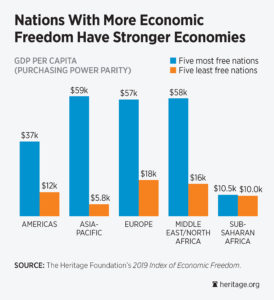When we last wrote about the Index for Economic Freedom, the U.S. had dropped to #18 in the world. A year later, it has leaped forward to #12.
That still puts us behind countries such as Switzerland, Australia and Ireland. It even puts us behind the United Kingdom, Canada and the United Arab Emirates. Yet it’s encouraging and shows that we’re heading in the right direction.
In 2008, the U.S. ranked fifth on the Index, with a score of 80.6 out of 100. With higher taxes and increased regulation during the Obama years after the Great Recession, the U.S. ranking dropped nine times in 12 years.
The improved ranking “reflects the impact of major regulatory and tax reforms on economic growth, investment, and business confidence,” according to The Heritage Foundation, which produces the index.
Next year’s ranking may be in danger, though, as, “New protectionist policies that have raised tariffs and disrupted established manufacturing supply chains are just beginning to affect consumer prices and investment decisions.”
The economic freedom ranking is based on factors covering four categories. Here is what the index says about the U.S. in each category:
- Rule of Law. Property rights are guaranteed, but protection has been uneven. For example, civil asset forfeitures by law enforcement and an expansion of occupational licensing requirements have encroached on property rights. The judiciary functions independently and predictably. Corruption is rare, but the Pew Research Center reported in late 2017 that only 18 percent of Americans trust the government always or most of the time.
- Regulatory Efficiency. Significant regulatory reform has resulted in the delay or withdrawal of 2,253 pending regulatory actions since January 2017. Successful challenges to compulsory unionization have expanded the right to work, but new minimum wage laws have curtailed low-income job opportunities in some areas. Subsidies for agriculture, health care, green energy, and corporate welfare continue to add billions of dollars per year to the U.S. national debt..
- Government Size. The top individual income tax rate is now 37 percent, and the top corporate tax rate has been cut to 21 percent. The overall tax burden equals 26.0 percent of total domestic income. Over the past three years, government spending has amounted to 37.8 percent of the country’s output (GDP), and budget deficits have averaged 4.1 percent of GDP. Public debt is equivalent to 107.8 percent of GDP.
- Open Markets. The combined value of exports and imports is equal to 26.6 percent of GDP. The average applied tariff rate is 1.7 percent. As of June 30, 2018, according to the WTO, the United States had 2,228 non-tariff measures in force. The Foreign Investment Risk Review Modernization Act and the Economic Growth, Regulatory Relief, and Consumer Protection Act (which amends certain aspects of the Dodd–Frank bill) were signed into law in 2018.
At least now the United States is ranked ahead of Denmark, Sweden, Finland and Norway, which many consider to be socialist states.
